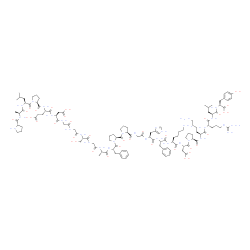Recombinant Human basic Fibroblast Growth Factor from Oryza sativa,OsrhbFGF

Recombinant Human basic Fibroblast Growth Factor from Oryza sativa,OsrhbFGF structure
|
Common Name | Recombinant Human basic Fibroblast Growth Factor from Oryza sativa,OsrhbFGF | ||
|---|---|---|---|---|
| CAS Number | 62031-54-3 | Molecular Weight | 1290.51 | |
| Density | 1.5±0.1 g/cm3 | Boiling Point | N/A | |
| Molecular Formula | C62H95N15O15 | Melting Point | N/A | |
| MSDS | USA | Flash Point | N/A | |
|
Xenopus laevis FGF receptor substrate 3 (XFrs3) is important for eye development and mediates Pax6 expression in lens placode through its Shp2-binding sites.
Dev. Biol. 397(1) , 129-39, (2015) Members of the fibroblast growth factor (FGF) family play important roles during various developmental processes including eye development. FRS (FGF receptor substrate) proteins bind to FGFR and serve as adapters for coordinated assembly of multi-protein comp... |
|
|
Fibroblast growth factor (Fgf) 21 is a novel target gene of the aryl hydrocarbon receptor (AhR).
Toxicol. Appl. Pharmacol. 278(1) , 65-71, (2014) The toxic effects of dioxins, such as 2,3,7,8-tetrachlorodibenzo-p-dioxin (TCDD), mainly through activation of the aryl hydrocarbon receptor (AhR) are well documented. Fibroblast growth factor (Fgf) 21 plays critical roles in metabolic adaptation to fasting b... |
|
|
Carbon ion beam is more effective to induce cell death in sphere-type A172 human glioblastoma cells compared with X-rays.
Int. J. Radiat. Biol. 90(12) , 1125-32, (2014) To obtain human glioblastoma cells A172 expressing stem cell-related protein and comparison of radiosensitivity in these cells with X-rays and carbon beam.Human monolayer-type A172 glioblastoma cells were maintained in normal medium with 10% bovine serum. In ... |
|
|
Calcineurin signaling regulates neural induction through antagonizing the BMP pathway.
Neuron 82(1) , 109-24, (2014) Development of the nervous system begins with neural induction, which is controlled by complex signaling networks functioning in concert with one another. Fine-tuning of the bone morphogenetic protein (BMP) pathway is essential for neural induction in the dev... |
|
|
Interactions between FGF18 and retinoic acid regulate differentiation of chick embryo limb myoblasts.
Dev. Biol. 396(2) , 214-23, (2014) During limb development Pax3 positive myoblasts delaminate from the hypaxial dermomyotome of limb level somites and migrate into the limb bud where they form the dorsal and ventral muscle masses. Only then do they begin to differentiate and express markers of... |
|
|
Co-operative Bmp- and Fgf-signaling inputs convert skin wound healing to limb formation in urodele amphibians.
Dev. Biol. 396(1) , 57-66, (2014) Urodele amphibians have remarkable organ regeneration capability, and their limb regeneration capability has been investigated as a representative phenomenon. In the early 19th century, nerves were reported to be an essential tissue for the successful inducti... |
|
|
RSK2 regulates endocytosis of FGF receptor 1 by phosphorylation on serine 789.
Oncogene 33(40) , 4823-36, (2014) FGFR1 (fibroblast growth factor receptor 1) regulates many key cellular responses including proliferation, migration and differentiation through activation of signaling pathways. Irregularities in FGFR1 signaling have been implicated in several pathological c... |
|
|
Role of adipose tissue in methionine-choline-deficient model of non-alcoholic steatohepatitis (NASH).
Biochim. Biophys. Acta 1842(7) , 959-70, (2014) Methionine-choline-deficient (MCD) diet is a widely used dietary model of non-alcoholic steatohepatitis (NASH) in rodents. However, the contribution of adipose tissue to MCD-induced steatosis, and inflammation as features of NASH are not fully understood. The... |
|
|
Lifelong caloric restriction reprograms hepatic fat metabolism in mice.
J. Gerontol. A. Biol. Sci. Med. Sci. 69(8) , 915-22, (2014) Calorie lowering slows the aging process and extends life span in diverse species by so far unknown mechanisms. The inverse linear relationship between calorie intake and life span suggests that regulators of energy metabolism are of importance in aging. The ... |
|
|
Identification of genetic risk factors for maxillary lateral incisor agenesis.
J. Dent. Res. 93(5) , 452-8, (2014) Tooth agenesis affects 20% of the world population, and maxillary lateral incisors agenesis (MLIA) is one of the most frequent subtypes, characterized by the absence of formation of deciduous or permanent lateral incisors. Odontogenesis is a complex mechanism... |